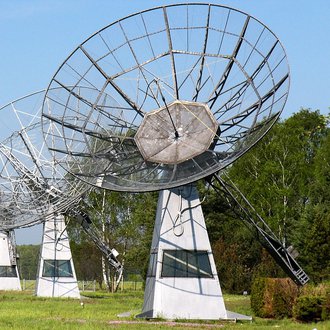Observatory for Solar Radio Astronomy (OSRA) Tremsdorf
Introduction: Why study coronal plasma processes by radio astronomy?
The corona is the outer part of the solar atmosphere and the source of the solar wind. It represents an inhomogeneous, hot, dilute, and fully ionized plasma. Its spatial structures are governed by the magnetic field. Important effects of stellar activity can be studied in the corona, such as coronal mass ejections (CMEs), flares and prominence eruptions, shock wave formation, and last but not least particle acceleration. Despite being of general astrophysical relevance these processes are not yet fully understood until now.
Plasma processes associated with solar activity take place on small spatial and temporal scales. If these processes are accompanied by electron acceleration (up to a few MeV) they can emit radio radiation. Consequently, such "nonthermal" electrons can be traced by radio methods. Solar radio observations are in some respect different from general radio astronomy. Signals are not extremely weak but highly varying in time and space. The background (the solar disc and its surroundings) is spatially extended and varying, too.
Various plasma processes (particle acceleration and transport; excitation of various wave modes) manifest themselves as solar radio burst patterns in dynamic radio spectra. The radio spectra can be used as one starting point of the theoretical study of basic plasma processes in the corona. Further, due to good spectral coverage, high time resolution, and high sensitivity, the Tremsdorf spectral observations yield an excellent guide and time line for assembling associated data sets from complementary ground- and space-based instrumentation.
Early history of solar radio observations at Potsdam
In the years 1893 - 1896 two scientists at Astrophysikalisches Observatorium Potsdam (still under its founding director Prof. Vogel), Johannes Wilsing and Julius Scheiner tried to detect the expected solar radio emission without using electronics. They applied the so-called coherer (in German "Fritter") effect - the decline of the Ohmic resistance between two wires in not too close contact due to the incidence of electromagnetic radiation.
In contrast with other early attempts these experiments are well documented. There are two published papers (in Astronomische Nachrichten August 1896; and in Wiedemanns Annalen, also 1896) carefully describing the experiments carried out on the Telegrafenberg in Potsdam. The "... first properly published experiment in radio astronomy ..." (W.T. Sullivan III, in Classics in Radio Astronomy, Reidel Dordrecht, 1982, p. 145) is even available in the English translation of the original paper published in Ann. der Physik und Chemie 59, p. 782-792 (1896) in W.T. Sullivan III (1982, p. 147-157).
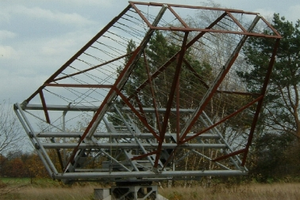
40-80 MHz
Credit: AIP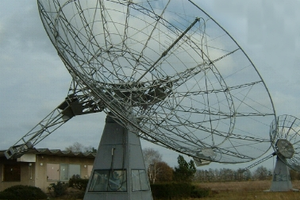
100-170 MHz
Credit: AIP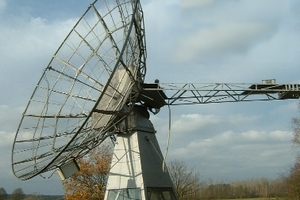
200-400 MHz
Credit: AIP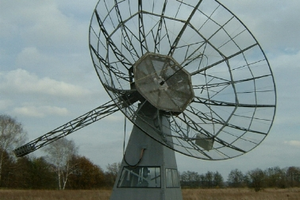
400-800 MHz
Credit: AIPAerials and receivers at Tremsdorf
Radio spectral observations were carried out near the village Tremsdorf 15 km south-east of Potsdam (52.284° N, 13.134° E). A set of four sweep spectrographs (10 sweeps per second) was fed by a system of four different aerials in the ranges 40 MHz - 100 MHz, 100 MHz -170 MHz, 200 MHz - 400 MHz, and 400 MHz - 800 MHz. We used a pair of crossed double-logarithmic Yagis, a 10.5 m paraboloid and two 7.5 m paraboloids. The parabolic aerials were parallactically mounted. This way we saw the sun at all frequencies as a star - no image resolution was obtained. The signal was a spatial integral over the radio noise of the whole sun. Strongest man-made interference was between 85 MHz and 108 MHz (local UHF radio), 170 MHz - 200 MHz (local UHF TV) and between 550 MHz and 700 MHz (local VHF TV). The daily observing time was as long as possible depending on the season (summer about 4 - 19 UT; winter about 8 - 14 UT).
For special observing campaigns two multichannel spectrometers could additionally be used: the decimeter spectrograph (multichannel spectrograph, 693 MHz - 740 MHz, time resolution 10 ms, bandwidth 1 MHz) and the meter wave multichannel polarimeter (chirp transform spectrograph, 316 MHz - 337 MHz, bandwidth 135 kHz, 10 ms time resolution if only measuring Stokes I, 20 ms time resolution if measuring Stokes I and V). The chirp spectrograph could also be positioned around a central frequency of 236 MHz.
Data archive and routine analysis
The whole observing process was robotically operated and could be remotely supervised. With 10 minutes steps the most current data was presented online. The raw data were saved on magnetic tape and - during manual event list processing - permanently stored on CD-ROMs ready for detailed scientific analysis.
An event list was routinely compiled, which included a morphological classification of radio burst emission: radio continua (noise storms, type IV, and V bursts), fast (type III and RS), slow (type II) drift bursts and spectral fine structures (e.g. pulsations, fiber bursts, spikes, type I bursts). This information was also included in the monthly event lists published in the NOAA Solar Geophysical Data. Reduced data sets in fits format were submitted to data pools of some solar-dedicated space missions (e.g. SOHO, SDO, RHESSI, STEREO).
Type II bursts are the radio signature of shock waves in the solar corona and the solar wind. They can be excited by a solar flare but also by an erupting prominence or a coronal mass ejection. The observation of type II bursts is of relevance for the space weather aspect of solar physics. Therefore we have compiled a list of all type II bursts observed at AIP since September 1993.
Data and event lists can be accessed via the OSRA data archive.
Involved AIP sections and groups:
Solar Physics